Our client is in a very competitive niche—cannabis and cannabis accessory sales in Canada. They have multiple locations throughout the Prairie Provinces, and their customers make purchases both online and in-store.
In this case study, we are going to examine how First Rank significantly improved this client’s ranking for competitive, high-converting keywords. We’ll explore some of the challenges that were facing the client, then discuss in-depth the tactics we used to address those challenges and grow our client’s business.Here are some of our incredible results: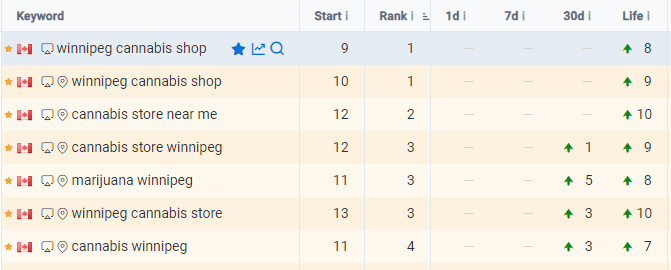

Challenge #1: Multiple Locations
Our client’s business has multiple physical locations, which presents both a challenge and an opportunity.
With multiple locations, an SEO agency must:
- Manage several different Google Business Profiles
- Promote physical traffic to each location without keyword cannibalization
- Ensure that the business ranks well for generic and broad local keywords, as well as long-tail hyper-local keywords
- Balance ecommerce keywords with keywords that promote visits to brick-and-mortar locations
The opportunities that accompany this challenge are quite straightforward—more locations means our client could generate significantly more brick-and-mortar business. SEO is a tremendous boon for brick-and-mortar businesses, because:
- 46% of all Google searches are for local information
- 72% of consumers that do a local search visit a store within an 8 km radius
Businesses with multiple locations can reap the benefits of SEO several times over, but a carefully managed keyword and content profile is needed.
Challenge #2: A Highly Competitive Niche
There are more cannabis stores in Winnipeg than there are Tim Hortons—and the keyword difficulty of some of the highest converting terms reflected this. Location-specific keywords with high commercial intent were fairly competitive:
This meant we would need a lot of high-quality content, a lot of backlinks, and a near-perfect degree of technical optimization to rank for the keywords we wanted to.
Challenge #3: Restrictions on Cannabis Marketing
Google does not allow Google Business Profile (GBP) posts for cannabis business profiles, which limited our ability to use certain GBP optimization strategies. GBP is essential to local SEO, so we needed to modify our approach.
Challenge #4: Poor Technical Optimization
Our client had a large website with hundreds of product pages; not at all uncommon for an ecommerce website. The problem was the poor optimization of these pages—images were improperly sized, schema was non-existent, 4XX errors were everywhere, and the site had a Core Web Vitals score of just 13—incredibly low.
Our Strategy
Address the most pressing technical issues
You can build all the content in the world with perfect keyword targeting, but if your site is so slow that it’s practically unusable, you won’t get far. Our team started by addressing the technical issues that were causing layout shifts, poor LCP scores, and other problems. This included:
- Optimizing images (serving them in optimized formats, sizing them appropriately, adding alt text, etc.)
- Minifying CSS and JS
- Reducing unused code
- And more
Here are some of the incredible results from our technical team’s work:
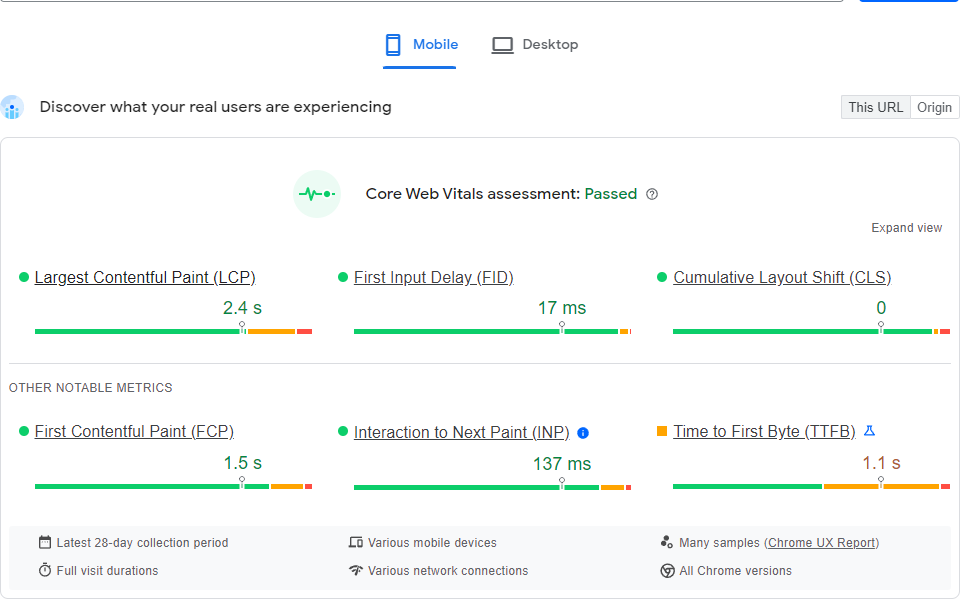

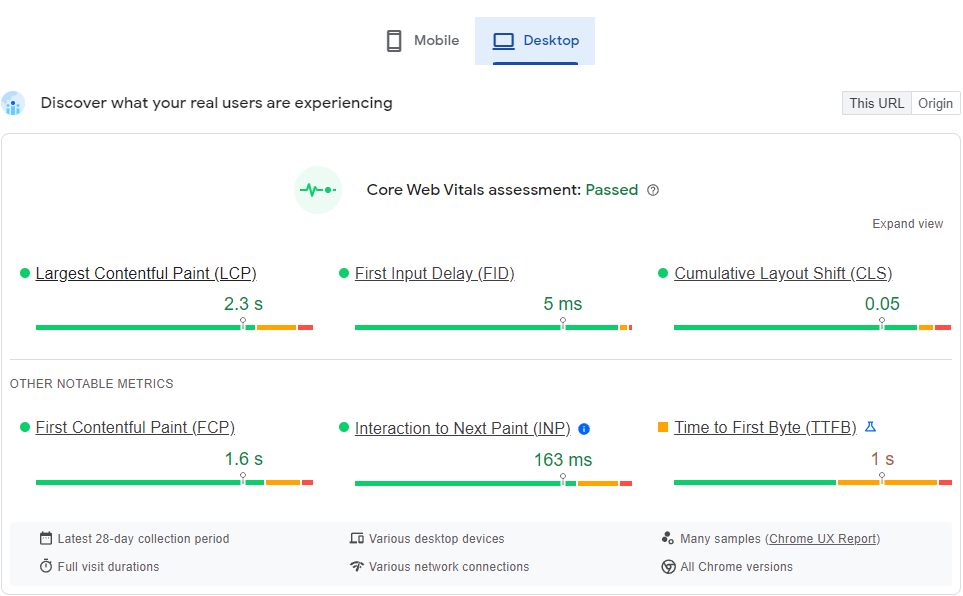

Negligible or non-existent layout shifts, incredibly fast loading speeds—and the improvements can be seen for both mobile and desktop traffic. With this, we established an excellent base on which we could build content and drastically improve user experience (UX).
Targeting the right keywords
Our client blends ecommerce and local SEO with multiple locations. As such, we had to target keywords for:
- Generic cannabis products (i.e. gas mask bongs)
- Hyper-local entities (i.e. cannabis store Garden City)
- Generic local terms (i.e. cannabis Winnipeg)
As always, our keyword strategy involved targeting a mix of long-tail and short-tail keywords. We prioritized keywords with a high conversion rate—these were often hyper-local commercial and transactional intent keywords.
We improved our client’s rank for a number of these high converting keywords. Here’s an example:


Creating location pages
To target the hyper-local keywords we were after, we created a number of different location pages. These pages served to cement our client’s website as the authoritative site for cannabis in these specific locations, helping us to rank for “cannabis store near me” style queries.
A challenge while creating these location pages was to ensure that they would rank for hyper-local keywords without cannibalizing keywords for cities like Winnipeg and Regina. As such, we avoided overusing city names and other broad local terms on these location pages—it was a careful balancing act.
Here are some of the results from our hyper-local location page tactics:
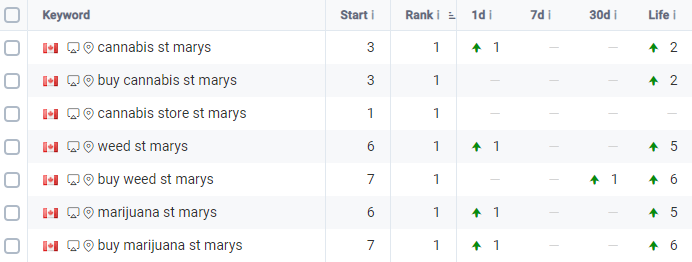

Creating location hubs
Unlike our hyper-local location pages, our location hubs were built to rank for terms like “cannabis store in Winnipeg”. These more generic terms have several advantages:
- They attract customers from anywhere in a broad region—once they’re on the site, they’ll find locations near them
- They have a much higher search volume than hyper-local terms
- They help to rank for “cannabis store near me” type searches
- They attract more ecommerce business
These broad location pages were the core of our hubs; the spokes were a variety of blog posts that all linked back to the hub location page. From there, the hubs all linked to the hyper-local pages within the city or province we targeted.
Shrewd internal linking and keyword targeting were used to ensure that our location hubs helped us rank for keywords and that some of their link equity was passed to the hyper-local location pages, but that broad keywords were never cannibalized by those hyper-local pages. To do so, we had to build our content very carefully—but as you’ll see in the results, it paid off.
Improving high-impression product pages
One of the challenges facing ecommerce businesses is product page optimization. Often, a company will end up with plenty of impressions for a relevant search, but they won’t be at the top of the search results, or they won’t get clicks for some other reason.
This was the case for our client, and we tackled this problem by focusing our ecommerce optimization efforts on these high-impression pages. We updated the content on these pages to help rank for Featured Snippets and other Rich Results, improved their meta descriptions and meta titles, and ensured that CTAs were visible above the fold.
Here are some example of high-impression, low click pages we optimized for:


Adding schema
Schema is structured data used to tell search engines and other entities about a given web page. Schema is particularly important for ecommerce product pages—the right schema allows search engines to display reviews, product information, and more.
We focused on two types of schema for our client: Product schema (especially aggregateRating schema) and LocalBusiness schema (for our location pages). This improved the quality of the search results and boosted user experience, giving searchers the vital information they needed about our client and their products.
Optimizing Google Business Profiles
With over a dozen physical locations, optimizing our client’s GBPs was one of our top priorities. Given that we could not make GBP Posts, we focused our efforts on a number of other tactics, including:
- Building many accurate name, address, and phone number (NAP) citations
- Ensuring that each GBP has unique content, including unique
- Descriptions
- Product pages
- Service pages
- Ensuring that each GBP linked to the appropriate location page, not to the main website
This allowed us to rank in the Google Business Profile 3-Pack for a wide variety of local search results, including “cannabis store near me”—one of the most competitive and high-converting keywords we targeted.
Standardization and future-proofing
With all of the issues that were plaguing the website addressed, we established a number of standards for image size, schema, and more, allowing us to ensure that all future product and location pages met the standards we had set. This has allowed our client to add numerous new pages since we started working with them—all without having to worry about missing out on optimization.
The Results
Our results were incredible: Our client is now ranking #1-#5 on a number of highly competitive keywords, drastically increasing the number of page views they’re getting. Those page views are more likely to lead to conversions, too, thanks to our decision to target high-converting keywords. Here are a few examples:




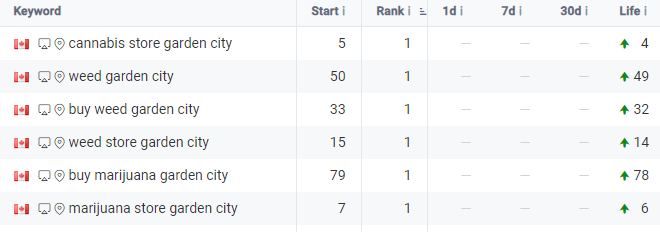



We’ve done well for both hyper-local and broader local keywords—and that’s led to more sales for our client.
There’s no one-size-fits-all strategy in SEO; you need to adapt your tactics for the specific challenges and opportunities facing each website. Our client was in a difficult niche, and we had to blend both ecommerce and local SEO strategies to succeed in helping all of their locations rank better.
We can adapt a strategy to the needs of your business, too. Give us a call for a free consultation—we’ll help you determine the best path forward for your business.


